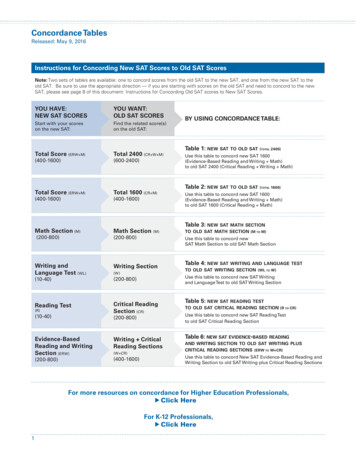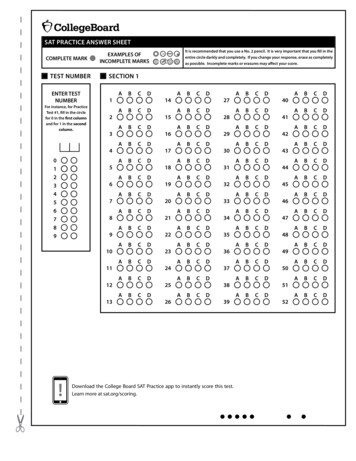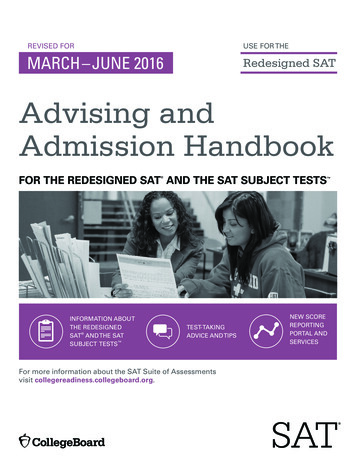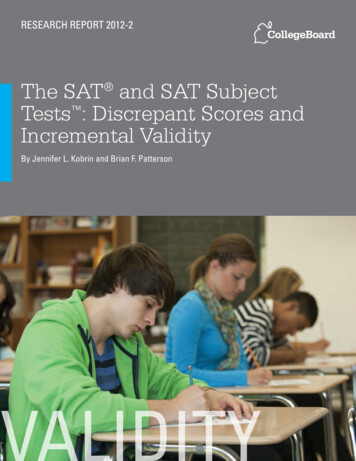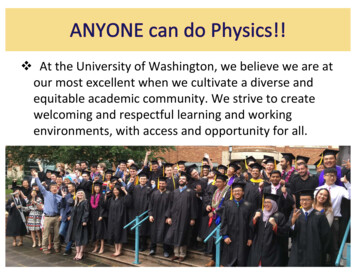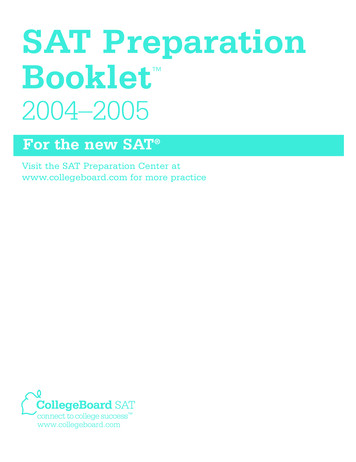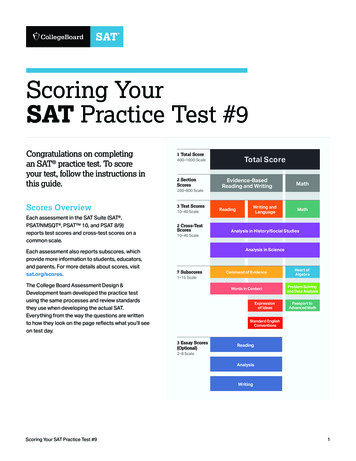
Transcription
SATIIPHYSICS(FROM SPARKNOTES.COM)Orientation1.0 Introduction to the SAT II2.0 Introduction to SAT II Physics3.0 Strategies for Taking SAT II PhysicsSAT II Physics Review4.0 Vectors1
5.0 Kinematics6.0 Dynamics7.0 Work, Energy, and Power8.0 Special Problems in Mechanics9.0 Linear Momentum10.0 Rotational Motion11.0 Circular Motion and Gravitation12.0 Thermal Physics13.0 Electric Forces, Fields, and Potential14.0 DC Circuits15.0 Magnetism16.0 Electromagnetic Induction17.0 Waves18.0 Optics19.0 Modern Physics20.0 Physics GlossaryPractice Tests21.0 Practice Tests Are Your Best FriendsIntroduction to the SAT IIThe SAT II Subject Tests are created and administered by the College Board and theEducational Testing Service (ETS), the two organizations responsible for producing thedreaded SAT I (which most people call the SAT). The SAT II Subject Tests were created toact as complements to the SAT I. Whereas the SAT I tests your critical thinking skills byasking math and verbal questions, the SAT II Subject Tests examine your knowledge of aparticular subject, such as Writing, U.S. History, Physics, or Biology. The SAT I takesthree hours; the Subject Tests take only one hour.In our opinion, the SAT II Subject Tests are better tests than the SAT I because they covera definitive topic rather than ambiguous critical thinking skills that are difficult to define.However, just because the SAT II Subject Tests do a better job of testing your knowledgeof a useful subject doesn’t mean the tests are necessarily easier or demand less studying.A “better” test isn’t necessarily better for you in terms of how easy it will be.2
The Good Because SAT II Subject Tests cover specific topics such as Grammar, Chemistry,and Biology, you can study for them effectively. If you don’t know the structure ofDNA, you can look it up and learn it. The SAT IIs are therefore straightforwardtests: if you know your stuff, you’ll do fine.Often, the classes you’ve taken in school have already prepared you well for theSAT IIs. If you’ve taken a Chemistry class, you’ve probably covered most of thetopics that are tested on the SAT II Chemistry test. All you need is somerefreshing and refocusing, which this book provides.The Bad Because SAT II Subject Tests quiz you on specific knowledge, it is much harder to“beat” or “outsmart” an SAT II test than it is to outsmart the SAT I. For the SAT I,you can use all sorts of tricks and strategies to figure out an answer. There are farfewer strategies to help you on the SAT II. Don’t get us wrong: having test-takingskills will help you on an SAT II, but knowing the subject will help you much,much more. In other words, to do well on the SAT II, you can’t just rely on yourquick thinking and intelligence. You need to study.Colleges and the SAT II Subject TestsWe’re guessing you didn’t sign up to take the SAT II just for the sheer pleasure of it. Youprobably want to get into college and know that the only reason for taking this test is thatcolleges want or require you to do so.Colleges care about SAT II Subject Tests for two reasons. First, the tests demonstrateyour interest, knowledge, and skill in specific subjects. Second, because SAT II tests arestandardized, they show how your knowledge of Chemistry (or History or Math)measures up to that of high school students nationwide. The grades you get in high schooldon’t offer such a measurement to colleges: some high schools are more difficult thanothers, and students of equal ability might receive different grades, even in classes with arelatively similar curriculum.When it comes down to it, colleges like the SAT IIs because the tests make the colleges’job easier. SAT II tests allow colleges to easily compare you to other applicants andprovide you with an excellent chance to shine. If you got a 93% on your Chemistry finaland a student at another high school across the country got a 91%, colleges don’t knowhow to compare the two grades. They don’t know whose class was harder or whoseteacher was a tougher grader. But if you get a 720 on the SAT II Chemistry and that otherkid gets a 650, colleges will recognize the difference in your scores.College PlacementOccasionally, colleges use SAT II tests to determine placement. For example, if you dovery well on the SAT II Chemistry, you might be exempted from a basic science class. It’s3
worth finding out whether the colleges you’re applying to use the SAT II tests for thispurpose.Scoring the SAT II Subject TestsThere are three different versions of your SAT II score. The “raw score” is a simple scoreof how you did on the test, like the grade you might receive on a normal test in school.The “percentile score” compares your raw score to all the other raw scores in the country,letting you know how you did on the test in relation to your peers. The “scaled score,”which ranges from 200 to 800, compares your score to the scores received by all studentswho have ever taken that particular SAT II.The Raw ScoreYou will never know your SAT II raw score because it is not included in the score report.But you should understand how the raw score is calculated because this knowledge canaffect your strategy for approaching the test.A student’s raw score is based solely on the number of questions that student got right,wrong, or left blank: You earn 1 point for every correct answerYou lose 1/ 4 of a point for each incorrect answerYou receive zero points for each question left blankCalculating the raw score is easy. Count the number of questions answered correctly andthe number of questions answered incorrectly. Then multiply the number of wronganswers by 1/4, and subtract this value from the number of right answers.raw score right answers - ( 1/4wrong answers)The Percentile ScoreA student’s percentile is based on the percentage of the total test takers who received alower raw score than he or she did. Let’s say, for example, you had a friend named GregorMendel, and he received a score that placed him in the 93rd percentile. That percentiletells Gregor that he scored better on the SAT II than 92 percent of the other students whotook the same test; it also means that 7 percent of the students taking that test scored aswell as or better than he did.The Scaled ScoreETS takes your raw score and uses a formula to turn it into the scaled score of 200 to 800that you’ve probably heard so much about.The curve to convert raw scores to scaled scores differs from test to test. For example, araw score of 33 on the Biology might scale to a 600, while the same raw score of 33 on theChemistry will scale to a 700. In fact, the scaled score can even vary between differenteditions of the same test. A raw score of 33 on the February 2004 Math IIC might scale toa 710, while a 33 in June 2004 might scale to a 690. These differences in scaled scoresexist to accommodate varying levels of difficulty and student performance from year toyear.4
Which SAT II Subject Tests to TakeThere are three types of SAT II test: those you must take, those you should take, andthose you shouldn’t take. The SAT II tests you must take are those required by the colleges you areinterested in.The SAT II tests you should take are tests that aren’t required, but that you’ll dowell on, thereby impressing the colleges looking at your application.The SAT II tests you shouldn’t take are those that aren’t required and cover asubject you don’t feel confident about.Determining Which SAT II Tests Are RequiredYou’ll need to do a bit of research to find out if the colleges you’re applying to require thatyou take a particular SAT II test. Call the schools you’re interested in, look at their websites, or talk to your guidance counselor. Often, colleges require that you take thefollowing SAT II tests: The SAT II Writing testOne of the two SAT II Math tests (either Math IC or Math IIC)Another SAT II in a subject of your choiceThe SAT II Chemistry is not usually required by colleges. But taking it and doing well canshow a liberal arts college that you are well-rounded or a science-oriented college thatyou are serious about science. In general, it is a good idea to take one science-based SATII, such as Biology, Chemistry, or Physics.Deciding If You Should Take an SAT II That Isn’t RequiredThere are two rules of thumb for deciding which additional test to take beyond theWriting and Math tests:1. Go with what you know. If history is your field, a strong score on theAmerican History test will impress admissions officers far more than a bold butmediocre effort on the Physics test.2. Try to show breadth. Scoring well on similar subject tests such as Math,Biology, and Chemistry will not be as impressive as good scores in more diversesubjects, such as Math, Writing, World History, and Biology.Of course, you also have to know what is considered a good score and whether or not youcan get that score (or higher).Below we have included a list of the most commonly taken SAT II tests and the averagescaled score on each. If you feel confident that you can get a score that is above theaverage (50 points or more), taking the test will probably strengthen your collegeapplication. Please note that if you are planning to attend an elite school, you might haveto score significantly higher than the national average. The following table is just a5
general guideline. It’s a good idea to call the schools that interest you or talk to a guidancecounselor to get a more precise idea of what score you should be shooting for.TestAverage ScoreWriting590–600Literature590–600American History580–590World History570–580Math IC580–590Math IIC655–665Biology E&M590–600Chemistry605–615Physics635–645As you decide which test to take, be realistic with yourself. Don’t just assume you’re goingto do great without at least taking a practice test and seeing where you stand.When to Take an SAT II Subject TestThe best time to take an SAT II Subject Test is right after you’ve finished a year-long classin that subject. If, for example, you take Chemistry in eleventh grade, then you shouldtake the SAT II Chemistry near the end of that year, when the material is still fresh inyour mind. (This rule does not apply for the Writing, Literature, and Foreign LanguageSAT II tests; it’s best to take those after you’ve had as much study in the area as possible.)Unless the colleges you’re applying to use the SAT II for placement purposes, there is nopoint in taking any SAT II tests after November of your senior year, since you won’t getyour scores back from ETS until after the college application deadline has passed.ETS usually sets testing dates for SAT II Subject Tests in October, November, December,January, May, and June. However, not every subject test is administered in each of thesemonths. To check when the test you want to take is being offered, visit the College BoardWeb site at www.collegeboard.com or do some research in your school’s guidance office.Registering for SAT II TestsTo register for the SAT II test(s) of your choice, you have to fill out some forms and pay aregistration fee. We know, we know—it’s ridiculous that you have to pay for a test thatcolleges require you to take in order to make their jobs easier, but, sadly, there isn’tanything we, or you, can do about it. (It’s acceptable here to grumble about the unfairnessof the world.)6
After grumbling, however, you still have to register. There are two ways to go about it:online or by mail. To register online, go to www.collegeboard.com. To register by mail, fill outand send in the forms enclosed in the Registration Bulletin, which should be available inyour high school’s guidance office. You can also request a copy of the Bulletin by callingthe College Board at (609) 771-7600 or writing to:College Board SAT ProgramP.O. Box 6200Princeton, NJ 08541–6200You can register to take up to three SAT II tests for any given testing day. Unfortunately,even if you decide to take three tests in one day, you’ll still have to pay a separateregistration fee for each.Introduction to SAT II PhysicsTHE BEST WAY TO DO WELL ON SAT II Physics is to be really good at physics. For that, thereis no substitute. But the physics whiz who spends the week before SAT II Physics cramming onLagrangian mechanics and Dirac notation probably won’t fare any better than the average studentwho reviews this book carefully. Why? Because SAT II Physics Tests (and first-year universitycourses) do not cover Lagrangian mechanics or Dirac notation. Take this moment to sigh withrelief.This chapter will tell you precisely what SAT II Physics will test you on, how the test breaksdown, and what format the questions will take. You should read this information carefully andbase your study plan around it. There’s no use spending hours on end studying for stuff that’s notrelevant to the test. Knowing nothing about electromagnetic induction will hurt you on the test,but nowhere near as much as knowing nothing about optics will.Content of SAT II PhysicsMath and physics go hand in hand, right? You might be surprised, then, to learn that you aren’tallowed to use a calculator on SAT II Physics. The math required of you never goes beyond simplearithmetic and manipulation of equations. You have, on average, 48 seconds to answer eachquestion, and the people at ETS realize that isn’t enough time to delve into problems involvingsimultaneous equations or complex trigonometry. They’re more interested in testing your grasp ofthe basic concepts of physics. If you’ve grasped these concepts, your weakness in math isn’t goingto hurt you.ETS breaks down the concepts you need to know for the test into six categories:TopicPercentage of the TestMechanics34–38%Electricity and Magnetism22–26%Waves15–19%Heat, Kinetic Theory, and Thermodynamics8–12%7
Modern Physics8–12%Miscellaneous2–4%While these categories are helpful, they are also very broad. You may be a whiz with waves but aloser with lenses, and want to know how much of the waves portion of the test will be devoted tooptics. To help you out, we’ve broken the test down even further so that you’ll know exactlywhere to expect to feel the squeeze. (These figures are only approximations, and may vary fromtest to test.)Topic% of the TestNumber of ematics6%4–5Dynamics10%7–8Work, Energy, and Power6%4–5Special Problems in Mechanics5%3–4Linear Momentum2%1–2Rotational Motion1%0–1Circular Motion and Gravitation4%2–4Thermal Physics8–12%6–10Heat and Temperature4%2–4Kinetic Theory and Ideal Gas Laws2–3%1–2Laws of Thermodynamics1%0–2Heat Engines2–3%1–2Electricity & Magnetism22–26%16–20Electric Fields, Forces, Potential10%7–8Magnetic Fields and Forces6%4–5Electromagnetic Induction1%1Circuits and Circuit Elements6%4–58
rn Physics8–12%6–9Special Relativity1–2%1–2Atomic Models3%2–3Quantum Physics2%1–2Nuclear Physics3%2–3Miscellaneous2–4%1–3Graph Analysis1–2%0–2Equation Manipulation0.5–1%0–1Significant Digits and Lab Skills0.5–1%0–1The chapters of this book are organized according to these categories. If a physics topic is not inthis book, you don’t need to know it. Here’s some other helpful information:You need to know: the formulas expressing physical relationships (such as F ma), how tomanipulate equations, how to read a graphYou don’t need to know: trig identities, calculus, three-dimensional vectors and graphs, physicalconstants (such as G 6.6710–11 N·m2 kg2)Format of SAT II PhysicsSAT II Physics is a one-hour-long test composed of 75 questions and divided into two parts. Youcan answer questions in any order you like, though you’re less likely to accidentally leave aquestion out if you answer them in the order in which they appear. Part A—classificationquestions—takes up the first 12 or 13 questions of the test, while Part B—five-choice completionquestions—takes up the remaining 62 or 63 questions.Part A: Classification QuestionsClassification questions are the reverse of normal multiple-choice question: they give you theanswers first and the questions second. You’ll be presented with five possible answer choices, andthen a string of two to four questions to which those answer choices apply. The answer choices areusually either graphs or the names of five related laws or concepts. Because they allow for severalquestions on the same topic, classification questions will ask you to exhibit a fuller understandingof the topic at hand.The level of difficulty within any set of questions is generally pretty random: you can’t expect thefirst question in a set to be easier than the last. However, each set of classification questions is9
generally a bit harder than the one that came before. You should expect questions 11–13 to beharder than questions 1–4.Classification Question ExampleDirections: Each setimmediately followingand then blacken theonce, more than once,of lettered choices below refers to the numbered questionsit. Select the one lettered choice that best answers each questioncorresponding space on the answer sheet. A choice may be usedor not at all in each set.Questions 1–3A boy throws a ball straight up in the air and then catches it again.1. . Which of the above graphs best represents the ball’s position with respect to time?2. . Which of the above graphs best represents the ball’s velocity with respect to time?3. . Which of the above graphs best represents the ball’s acceleration with respect to time?ExplanationYou can usually answer classification questions a bit more quickly than the standard five-choicecompletion questions, since you only need to review one set of answer choices to answer a seriesof questions.The answer to question 1 is B. The ball’s position with respect to time can be expressed by theequation y –1/2 gt2, where g is the downward, acceleration due to gravity. As we can see, thegraph of y against t is an upside-down parabola. In more intuitive terms, we know that, over time,a ball thrown in the air will rise, slow down, stop, and then descend.The answer to question 2 is E. The acceleration due to gravity means that the velocity of the ballwill decrease at a steady rate. On the downward half of the ball’s trajectory, the velocity will be10
negative, so E, and not A, is the correct graph.The answer to question 3 is D. The acceleration due to gravity is constant throughout the ball’strajectory, and since it is in a downward direction, its value is negative.Don’t worry if the question confused you and the explanations didn’t help. This material and morewill be covered in Chapter 2: Kinematics. This was just an exercise to show you how aclassification question is formatted.Part B: Five-Choice Completion QuestionsThese are the multiple-choice questions we all know and love, and the lifeblood of any multiplechoice exam. You know the drill: they ask a question, give you five possible answer choices, andyou pick the best one. Got it? Good. An example appears below.While you’ll often find two or three questions in a row that deal with the same topic in physics,there is no pattern. You might find a question on modern physics followed by a question ondynamics followed by a question on optics. However, there is a general tendency for the questionsto become more difficult as you progress.Five-Choice Completion Question ExampleDirections: Each of the questions of incomplete statements below is followed by fivesuggested answers or completions. Select the one that is best in each case and then fill inthe corresponding oval on the answer sheet.1. . A gas in a closed container is steadily heated over a period of time. Which of the followingstatements is true of this process?(A) The average kinetic energy of the gas molecules decreases(B) The mass of the container increases(C) The pressure exerted by the gas on the walls of the container increases(D) The gas changes phase into a liquid(E) The specific heat of the gas decreasesExplanationThe answer to this question is C. The key lies in remembering the ideal gas law: PV nRT.According to this formula, an increase in temperature is accompanied by an increase in pressure. Ais wrong, since the average kinetic energy of gas molecules corresponds to their temperature: ifthe temperature increases, so does the average kinetic energy of the molecules. B is wrong becausewe’re dealing with a closed container: the mass cannot either increase or decrease. D is wrongbecause a gas must be cooled, not heated, to change phase into a liquid. Finally, E is wrongbecause the specific heat of any substance is a constant, and not subject to change. We’ll touch onall this and more in Chapter 9: Thermal Physics.How Your Knowledge Will Be TestedThere are three different levels on which your understanding of physics may be tested. Whilequestions on kinematics often require that you make use of some of the formulas for kinematicmotion, questions on quantum physics or atomic structure may often ask just that you rememberthe name of a particular concept. Knowing the different ways in which your knowledge may betested should help you better prepare yourself for the exam.11
Recall (20–33% of the test)These are questions of the either-you-know-it-or-you-don’t variety. They test your understandingof the basic concepts of physics. No equations or calculations are necessary for these questions.They’re simply a matter of knowing your stuff.Single-Concept Problem (40–53% of the test)These questions expect you to recall, and make use of, one physical relationship, formula, orequation. This might involve plugging numbers into a kinematic equation of motion, or it mightinvolve recalling the equation E hf and solving for E or f. These questions test to see if youknow important formulas and how to apply them.Multiple-Concept Problem (20–33% of the test)These questions expect you to bring together two or more different relationships, formulas, orequations. This could involve bringing together two formulas from the same subject—for instance,a problem in linear momentum that requires you to calculate the momentum of an object before acollision so that you can calculate its velocity after the collision—or it may bring togetherformulas from two different subjects—for instance, a problem that involves an electric pointcharge moving in circular motion in a magnetic field. These questions test not only yourknowledge of physical relationships, but also your ability to integrate more than one in a complexproblem.You’re probably thinking that the recall questions are the easiest, and the multiple-conceptproblems are the hardest. This isn’t necessarily true. Most people have an easier time bringingtogether two simple principles of mechanics than recalling the significance of the Rutherfordexperiment. You’ll find all three types of questions throughout the test, and at different levels ofdifficulty. Ultimately, every question tests the very same thing: whether you’ve grasped the basicprinciples of physics.Strategies for Taking SAT II PhysicsA MACHINE, NOT A PERSON, WILL SCORE your SAT II Physics Test. The tabulatingmachine sees only the filled-in ovals on your answer sheet, and doesn’t care how you came tothese answers; it just impassively notes if your answers are correct. A lucky guess counts in yourfavor just as much as an answer you give confidently. By the same token, if you accidentally fill inB where you meant C, you won’t get any credit for having known what the answer was. Think ofthe multiple-choice test as a message to you from ETS: “We care only about your answers. We donot care about the work behind those answers.”So you should give ETS as many right answers as possible. The SAT II Physics Test not onlyallows you to show off your knowledge of physics, it allows you to show off your foxlike cunningby figuring out what strategies will enable you to best display that knowledge. This chapter willfirst cover some general principles of test taking that apply equally to this test and any other SATtest you might take, then it will discuss a few strategies that are particularly useful to SAT IIPhysics.General Test-Taking StrategiesMost of these “strategies” are common sense; many of them you already know. But we’re12
including them anyway because it’s amazing how a timed test can warp and mangle commonsense. If you review anything in the minutes before taking the test, review these strategies.General Hint 1: Be CalmThe best way to do poorly on a test is to psych yourself out. Physics in particular calls for cool,systematic thinking: if your mind starts thrashing about wildly, it will have a hard time settling onthe right answers. There are a number of preventative measures you can take, beginning weeks, oreven months, before the test date. Buying this book was a good start: it’s reassuring to see all theinformation you’ll need to ace the test in a compact, manageable form. But there are a number ofother things you ought to keep in mind:Study in advance.If you’ve studied at regular intervals leading up to the test, and don’t do all your cramming thenight before, the information will sit more securely in your mind.Be well rested.Get a good night’s sleep on the two nights leading up to the test. If you’re frazzled or wired,you’re going to have a harder time buckling down and concentrating when it really counts.Come up for air.Don’t assume that the best way to take an hour-long test is to spend the full hour nose-to-nosewith the test questions. If you lift your head occasionally, look about you, and take a deep breath,you’ll return to the test with a clearer mind. You’ll lose maybe ten seconds of your total test-takingtime, but you’ll be all the more focused for the other fifty-nine minutes and fifty seconds.General Hint 2: Fill in Your Answers CarefullyThis is very important. People make mistakes filling in their answer sheets and it can cost thembig-time. This slip up occurs most frequently after you skip a question. If you left question 43blank, and then unthinkingly put the answer to question 44 into row 43, you could start a long,painful chain of wrong answers. Don’t do this.Some test prep books advise that you fill in your answer sheet five questions at a time rather thanone at a time. Some suggest that you fill out each oval as you answer the question. We think youshould fill out the answer sheet in whatever way feels most natural to you, but make sure you’recareful while doing it. In our opinion, the best way to ensure that you’re being careful is to talk toyourself: as you figure out an answer in the test booklet and transfer it over to the answer sheetovals, say to yourself: “Number 23, B. Number 24, E. Number 25, A.”General Hint 3: Pace YourselfAt the very least, aim to look at every question on the test. You can’t afford to lose points becauseyou didn’t have the time to look at a question you could have easily answered. You can spend anaverage of forty-eight seconds on each question, though you’ll probably breeze through some inten seconds and dwell on others for two minutes. Knowing how to pace yourself is a critical skill—and these three guidelines should help:Don’t dwell on any one question for too long.If you’ve spent a couple minutes laboring over the question, you might just want to make a note ofit and move on. If you feel the answer is on the tip of your tongue, it might come more easily ifyou just let it rest and come back to it later. Not only is it demoralizing to spend five minutes on asingle question, but it also eats up precious time in which you might have answered a number ofeasier questions.Nail the easy questions.13
As we said in the previous chapter, the test questions get progressively harder as you go along.Nonetheless, there will be some tough ones thrown in right at the start, and you’ll find giveawaysright up until the end. If you dwell too long on tough questions, you jeopardize your chances oflooking at every question and gaining points for the easy ones. Remember: you get as many pointsfor answering an easy question as a difficult one, and you get a lot more points for five quicklyanswered easy questions than for one hard-earned victory.Skip the unfamiliar.If you encounter a question you can’t make heads or tails of, just skip it. Don’t sweat too hardtrying to sort out what’s going on. If you have time at the end, come back to it and see if you canmake an educated guess. Your first priority should be to get all the easy questions, and yoursecond priority should be to work through the questions you can solve with some difficulty.Unfamiliar material should be at the bottom of your list of priorities.General Hint 4: Set a Target ScoreYou can make the job of pacing yourself much easier if you go into the test knowing how manyquestions you have to answer correctly in order to earn the score you want. So, what score do youwant? Obviously, you should strive for the best score possible, but also be realistic: consider howmuch you know about physics and how well you do, generally, on SAT-type tests. You should alsodo a little research and find out what counts as a good score for the colleges you’re applying to: isit a 620? a 680? Talk to the admissions offices of the colleges you might want to attend, do a littleresearch in college guidebooks, or talk to your guidance counselor. Find out the average score ofstudents admitted to the schools of your choice, and set your target score above it (you want to beabove average, right?). Then take a look at the chart we showed you before. You can score:800 if you answered 68 right, 7 wrong, and left 0 blank750 if you answered 58 right, 12 wrong, and left 5 blank700 if you answered 51 right, 13 wrong, and left 11 blank650 if you answered 43 right, 16 wrong, and left 16 blank600 if you answered 36 right, 19 wrong, and left 20 blankSuppose the average score on SAT II Physics for the school you’re interested in is 650. Set yourtarget at about 700. To get that score, you need to get 51 questions right, which leaves you room toget 13
1.0 Introduction to the SAT II 2.0 Introduction to SAT II Physics 3.0 Strategies for Taking SAT II Physics SAT II Physics Review 4.0 Vectors 1. 5.0 Kinematics 6.0 Dynamics 7.0 Work, Energy, and Power 8.0 Special Problems in Mechanics 9.0 Linear Momentum 10.0 Rotational Motion


